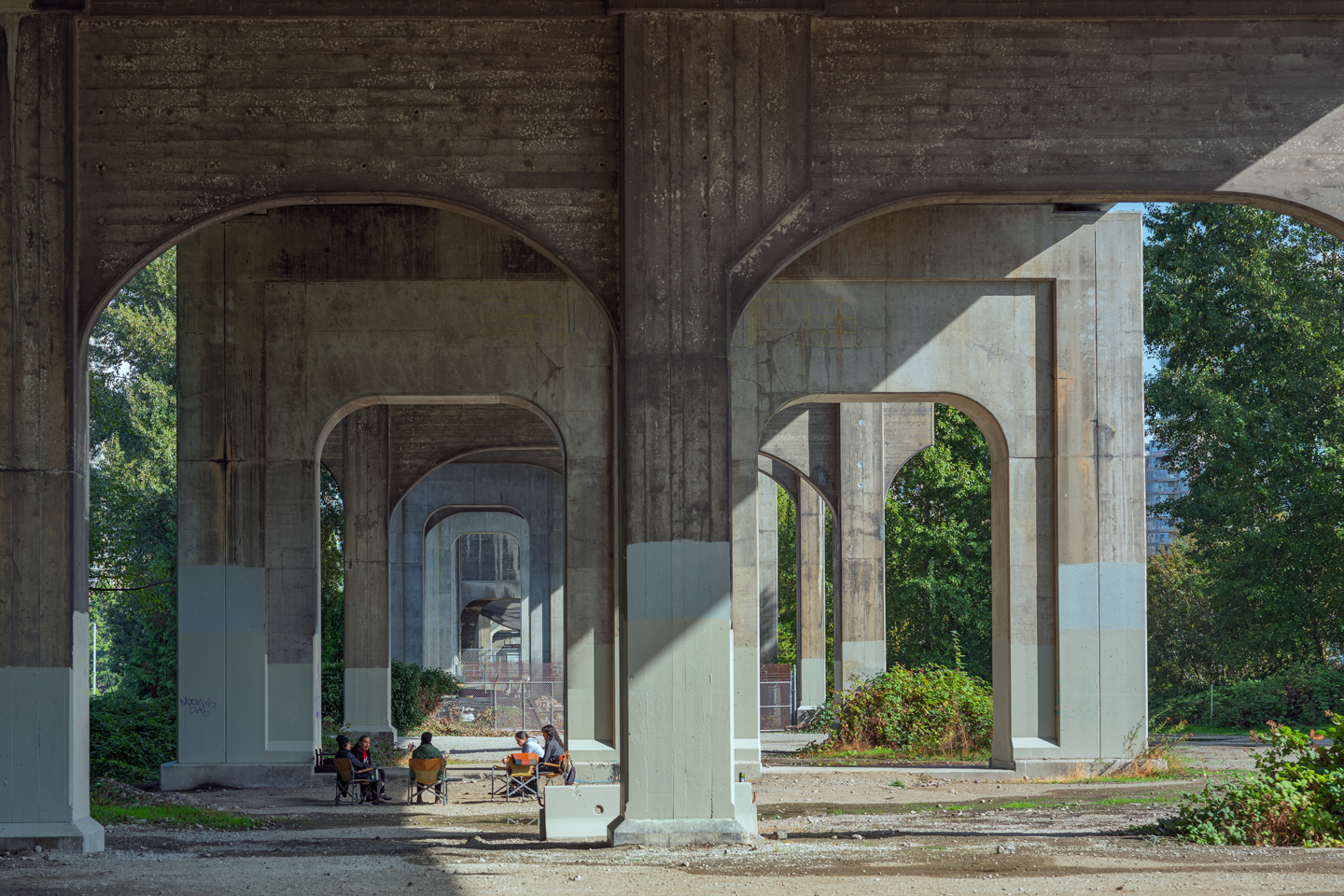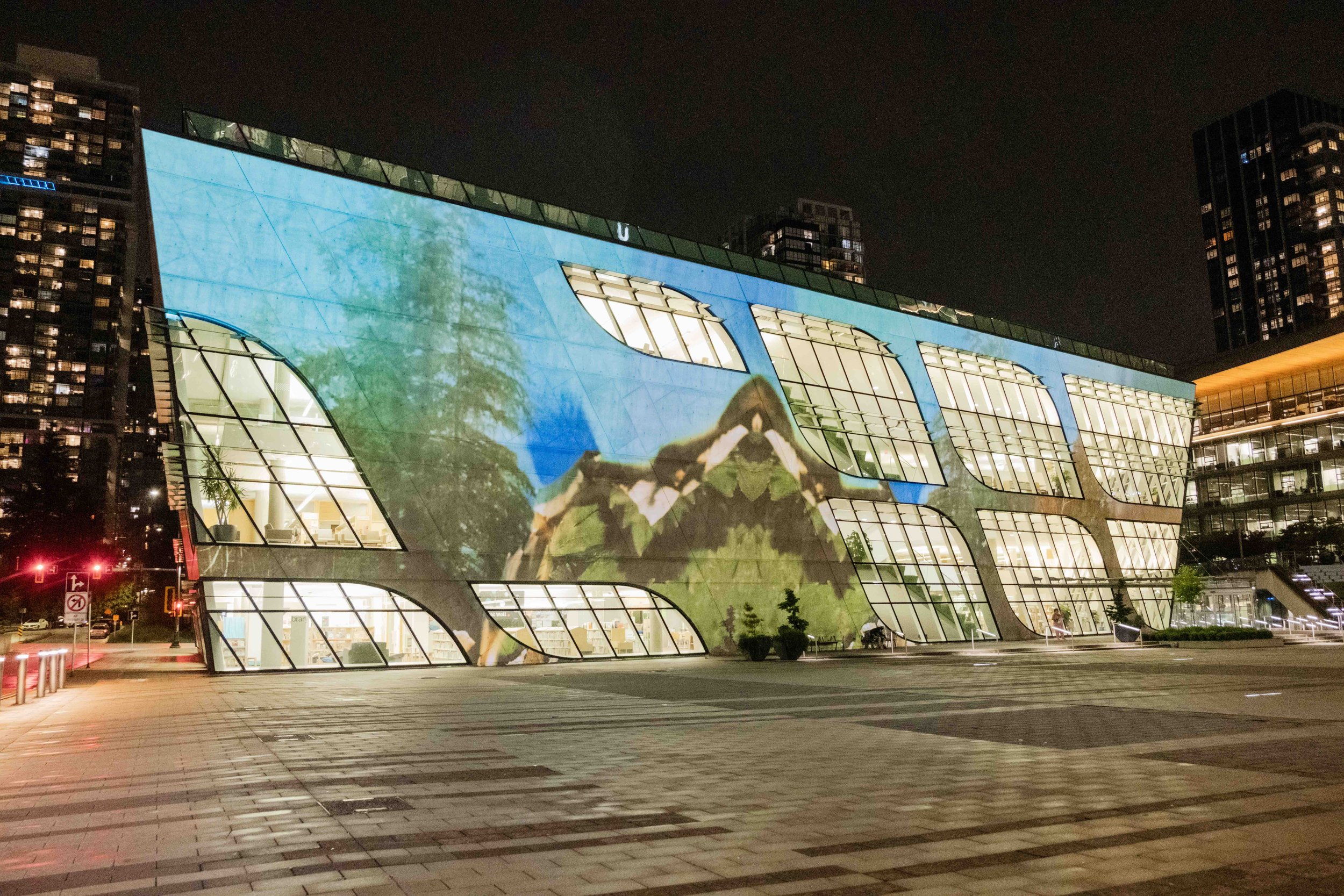At the Gordon Smith Gallery, Prevailing Landscapes contrasts Canada's distinct wilderness with urban forces
Monumental exhibition unites works by celebrated Canadian contemporary artists, including Jin-me Yoon, Ian Wallace, Cameron Kerr, and Stan Douglas
Stan Douglas’s View of Clearcuts from Blowhole Bay from the “Nootka Sound” series, 1996, chromogenic print.
Gordon Smith Gallery of Canadian Art presents Prevailing Landscapes to June 22 as part of the Capture Photography Festival
WHEN YOU WALK into Prevailing Landscapes at the Gordon Smith Gallery of Canadian Art, two abstract wood sculptures by Campbell River–born multimedia artist Cameron Kerr immediately catch the eye.
Situated on small podiums, one of the life-sized pieces is composed of geometrical shapes nestled against one other—a hemisphere poised on its side, oblong hollow boxes with rounded corners, a thimble-like protrusion—and another resembles the shape of a vertically oriented peanut, with large holes carved smoothly into it. The rounded edges and sanded finish of the raw wood make it seem as though both sculptures are constantly morphing into new forms. Kerr’s works, which are pieces of the natural world shown in a formal gallery setting, set the tone for an exhibition that juxtaposes distinct Canadian scenery with human-made forces.
The sculptures invite visitors into a high-calibre space, presented as part of this year’s Capture Photography Festival, that’s lined with pieces by some of the most prominent names in contemporary Canadian art: Jin-me Yoon, Ian Wallace, Kim Dorland, Stan Douglas, Tim Gardner, Krystle Silverfox, and Karen Zalamea.
Though many of the artists’ works touch upon larger thematic concepts, what unites them in Prevailing Landscapes is how each piece offers new perspectives on distinct Canadian scenery. Speaking to Stir at a media tour of the exhibition, Prevailing Landscapes curator Jackie Wong offers some insight into her process for compiling the selection of art on display.
“When I looked into and chose these works, it was the artist who had a story, but the Canadian landscape was a part of that story,” Wong explains. “It wasn’t about, ‘Oh, they’re talking about land claims. They’re talking about the environment. They’re talking about cultural identity.’ No. I wanted to choose works that were truly Canadian, and Canadian because of the landscape that was included. That’s why it’s called Prevailing Landscapes.”
Cameron Kerr’s Heart, 2024, inkjet on paper.
Kerr’s larger body of work, which sees him exploring the Canadian landscape, is emblematic of this theme. His 2021 photo, Mquqwin: Brooks Bay 1, features wood bipyramids stacked vertically on a tree stump, set atop a forested peak overlooking a bay in northwestern Vancouver Island’s Mquqwin / Brooks Peninsula Park.
During the tour, Wong breaks down Kerr’s process: he gets permission from an Indigenous community when venturing off the beaten path into a forested area, finds a spot he’s pleased with, carves a sculpture out of a tree stump with his chainsaw—sometimes camping out for a couple of days to finish his work—documents it with a photograph, and then leaves it behind.
Elsewhere in B.C.’s natural landscape, some 25 years earlier, Stan Douglas was photographing his nine-part “Nootka Sound” series, of which six 1996 chromogenic prints are on display together: View of the Spanish Pilot Group from Yuquot, Fish Trap at the Inlet, Tahsis Mill, Gold River Mill, Beachcomber’s Float Between King and Williamson Passages, and View of Clearcuts from Blowhole Bay (which is captured in the same region where Kerr’s sculpture now hides). The photographs show prominent views of tree-lined mountainscapes, rippling water, and cloud-covered skies dotted with human presence—smoke rising from a pulp mill, a run-down cabin in the distance.
On display in Vancouver for the first time in more than 20 years, this series is—for Wong—a true representation of the Canadian landscape. It symbolizes the cyclical nature of the land, from its first Indigenous inhabitants, to its industrialization, to its return to nature.
Hung prominently across from Douglas’s works is Yoon’s 2022 chromogenic photo print, Listening Place (Under Burrard Bridge), another shining example of how Prevailing Landscapes takes a critical look at the way we view the Canadian wilderness. The image shows a meeting between Hereditary Chief Bill Williams (találsamkin siyám) of the Squamish Nation and Yoon’s mother Chung-soon, accompanied by an adult child from each family, all hunkered down on camping chairs set up underneath the Art Deco arches of the Burrard Street Bridge.
The gathering, historically symbolic, brings together two cultures that have been colonized by others. One chair is left empty, says Wong, to acknowledge that an ancestor is there contributing to the conversation spiritually.
The curator compares South Korea-born, Vancouver-based Yoon to “the director of a movie.” The artist envisioned a concept for Listening Place, and then prepared and staged the shot over the course of three days.
Jin-me Yoon’s Listening Place (Under Burrard Bridge), 2022, chromogenic print.
“Jin-me talks about how looking here is looking into the past, and looking into the future,” Wong remarks of Listening Place during her tour, noting that the spot where the photo was taken just a couple of years ago now looks completely different. “The Squamish people have claimed the land back, and they’re developing it into housing down there, which is amazing,” she says. “Jin-me works very closely with the Squamish and Tsleil-Waututh Nations to let them guide her in her practice.”
At the other end of the exhibition is a small room sectioned off by a thick black curtain, where Yoon’s single-channel video, Dreaming Birds Know No Borders, is projected onto a wall. Set against the backdrop of the Maplewood Flats Conservation Area in North Vancouver, a figure bends slowly at the hips, hands raised behind their back, as the sun reflects off the low tide of the Burrard Inlet. Clips of a seagull picking at shells, a person peering through binoculars, and geese flying overhead are intermixed with pixelated media.
The video is accompanied by three companion prints from the Becoming Crane (Pacific Flyways) series; altogether, the works link the Maplewood Flats with the biodiverse Korean Demilitarized Zone between South and North Korea, juxtaposing natural landscapes with industrial backdrops in an inquiry into what it means to reside on unceded land. Wong notes that Yoon’s works displayed here weren’t included in the Vancouver Art Gallery’s expansive exhibition Jin-me Yoon: About Time last spring, meaning they’re brand new to Vancouver audiences.
Across the room, Filipino-Canadian interdisciplinary artist Karen Zalamea’s archival inkjet print, The Joyce-Collingwood Food Hub, examines cultural identity in a more urban way, highlighting East Vancouver businesses operated by the Filipino diaspora. Zalamea created the panorama-style cityscape photo by stitching together a whopping 60 individual images, capturing a slice of culture and community that’s under the threat of being dwarfed by a development proposal.
Ian Wallace’s In the Street (Lyse), 1988, inkjet print and mono-print.
Next to Zalamea’s work is Ian Wallace’s 1988 diptych piece, In the Street (Lyse), from his “Heroes in the Street” series, which pairs an inkjet photograph of the Cambie Bridge with an amber wood-grain monoprint on two side-by-side canvases. Wong notes that Wallace’s signature colour-blocking (which art enthusiasts will recognize as a major component of his Home and Away, exhibiting at the West Vancouver Art Museum to May 4) doesn’t have a grand hidden meaning behind it; rather, it symbolizes a contrast between urban and nature, adding visual interest to the photograph it accompanies.
Another of Wallace’s works, Disaster, figures in a gallery wall across the room. Shot in 1958 when he was just 14 years old, the black-and-white photo depicts the Second Narrows Bridge moments after its fatal collapse. “His dad came to school, grabbed him out of class, and said, ‘We have to go,’” Wong recounts. “Ian grabbed his camera and took the photo.”
Walking through Prevailing Landscapes is akin to seeing a dreamscape of Canada’s past, present, and future. The artists featured here are doing vital work documenting the country’s diverse communities, culture, beauty, and flaws, all while conveying distinct creative voices.
There will be plenty of opportunities this month and next to tour the exhibition in depth, including live carvings with Kerr on April 26 and 27; a conversation between Kerr, Wong, and scholar Patrik Andersson on April 27; and Art Education Unveiled: Perspectives from Prevailing Landscapes—a discussion between Douglas, Silverfox, Wallace, and Zalamea facilitated by Andrew Booth—on May 9. (At one point, Wong tells Stir, there may be an opportunity for kids to “graffiti” one of Kerr’s wooden sculptures at the gallery.)
“These works are amazing,” the curator says of the exhibition, looking around her at the vast representations of the Canadian landscape that line the space. “It’s also the first time these artists have ever been shown together,” she adds. Fingers crossed that it’s not the last. ![]()
Karen Zalamea’s The Joyce-Collingwood Food Hub, 2022–23, archival inkjet print.


















